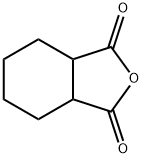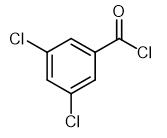Synthesis and Application of Hexahydrophthalic anhydride
General description
Hexahydrophthalic anhydride can be used as curing agent of epoxy resin. Low melting point, can be mixed with resin at low temperature, low viscosity of the mixture, long service life (6 days), curing heat is small. Mainly used for casting products.
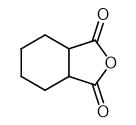
Fig. 1 The structure of Hexahydrophthalic anhydride.
Synthetic routes

Fig. 2 The synthetic method 1 of Hexahydrophthalic anhydride.
Combine ciscyclohexane-1, 2-dicarboxylic acid (1 mmol, 172 mg) and oxalyl chloride (1.2 mmol, 152 mg, 0.103 ml) in dry toluene (5 mL) and add a drop of freshly distilled DMF. Purge the reaction vessel with argon and heat the reaction under stirring for 3 h. Stop the stirring, decant the toluene solution and filter. Evaporate the volatiles. Transform into crystalline form by trituration with diethyl ether. 1H NMR (400 MHz, CDCl3) δ 3.18 - 3.12 (m, 2H 2CH) 1.96 - 1.83 (m, 4H 2CH2) 1.57 - 1.49 (m, 4H 2CH2). HRMS (ESI), calcd for C8H10NaO3 [M+Na]+ 175.0522, found 175.0527; calcd for C9H14NaO4 [M+CH3 OH+Na]+ 209.0784, found 209.0788 [1].
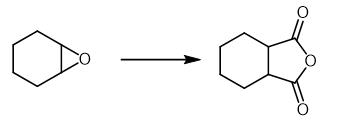
Fig. 3 The synthetic method 2 of Hexahydrophthalic anhydride.
Carry out the cycloaddition reaction of CO2 with epoxides in a stainless steel autoclave with 25 cm3 inner volume. Add nanocatalyst (0.50 mol%) and epoxide (14.3 mmol) into the autoclave with a magnetic stirrer at 500 rpm. Charge a constant pressure of CO2 into the autoclave at room temperature and heat to a preset temperature for an reaction time. Warm the autoclave to room temperature, depressurize and dilute the solution mixture with toluene. Add biphenyl into the diluted solution as an internal standard and determine the product by GC (Agilent 7890A) and GC-MS (Agilent 6890N/5975B). Remove the solvent and purify the product from silica gel column chromatography by using ethyl acetate/petroleum (1 : 10) as the eluent [2].
Detection method
Methods for sampling and determination of four organic acid anhydrides are described. The methods were validated in a standard atmosphere and in the work environment, Hexahydrophthalic anhydride (HHPA), methylhexahydrophthalic anhydride (MHHPA), tetrahydrophthalic anhydride (THPA) and octenylsuccinic anhydride (OSA) were sampled using Tenax and Amberlite XAD-2 solid sorbents and determined by GC; with flame ionization detection (FID) after elution, The precision was normally better than 10% but for OSA it was up to 19%, The detection limits were 0.1 mu g per sample. MHHPA, THPA and OSA were also sampled using bubblers containing aqueous sampling solutions, MHHPA and THPA was derivatized with pentafluorobenzyl bromide (PFBBr) and determined by GC with MS detection, OSA was derivatized by methanol with boron trifluoride catalysis and determined by GC-FID. The precisions for MHHPA and THPA were 4 and 8%, respectively, and the detection limit was < 0.005 mu g per sample. The precision for OSA was up to 58% and the detection limit was 0.2 mu g per sample. HHPA and MHHPA were also sampled on glass-fibre filters, derivatized with PFBBr, and determined by GC-MS with good results. However, further validations of the filter methods are needed [3].
Risk-factors
Our objective was to identify risk factors for development of immunologically mediated respiratory disease in workers exposed to hexahydrophthalic anhydride. We performed a medical and immunologic survey study of 57 workers in a workplace molding operation utilizing hexahydrophthalic anhydride. The main outcome measurements were the development of a respiratory disease due to specific IgE antibody (asthma and/or rhinitis) or specific IgG antibody (hypersensitivity pneumonitis or hemorrhagic rhinitis). Of the 57 workers, 7 had both IgE- and IgG-mediated disease, whereas 9 had only IgE-mediated disease. Although neither smoking, age, nor race were risk factors for development of immunologically mediated disease, exposure level and specific antibody were. In conclusion, development of immunologically mediated respiratory disease due to hexahydrophthalic anhydride is most closely associated with exposure level and development of specific IgE or IgG antibodies [4].
Occupational immunologic lung diseases caused by exposures to substances such as hexahydrophthalic anhydride are significant health problems. It would be useful to identify risk factors, other than exposure, for occupational immunologic lung diseases such as occupational asthma. Our objective was to identify risk factors for development of immunologically mediated disease in workers with respiratory symptoms associated with exposure to hexahydrophthalic anhydride. A medical and immunologic survey study was conducted of 33 employees with respiratory symptoms associated with hexahydrophthalic anhydride exposure. Of the 33 employees with respiratory symptoms, 20 had no immunologically mediated disease. Seven had both immunoglobulin E-mediated and immunoglobulin G-mediated disease, 5 had immunoglobulin E-mediated disease only, and 1 had immunoglobulin G-mediated disease only. Although larger samples would have rendered atopy a statistically significant risk factor (assuming effect replication), the associated effect strength represents less than a 16% improvement versus chance, which is indicative of marginal clinical significance. However, as expected, elevated levels of specific antibodies were statistically and clinically significant risk factors. Development of one type of immunologically mediated disease was highly predictive of development of the other type. In hexahydrophthalic anhydride-exposed employees with respiratory symptoms, development of immunologically mediated respiratory disease is most closely associated with presence of specific immunoglobulin E or immunoglobulin G antibodies. Neither race, age, smoking status, atopy, nor exposure levels emerged as significant risk factors in this symptomatic study population [5].
Application
As component of epoxy-resin
Seventeen workers with occupational exposure to hexahydrophthalic anhydride from an epoxy resin system were studied to evaluate the nature of their respiratory complaints. The workers were evaluated by questionnaire, pulmonary function tests, serological investigations, and skin tests. Low-molecular-weight chemicals like anhydrides of dicarboxylic acids, capable of reaction with human serum proteins and of formation of hapten-carrier conjugates, can produce pathogenic immunoreactions. The presence of serum-specific IgE to anhydride conjugates was measured by use RAST. The presence of serum-specific IgE to anhydride conjugates was measured by use RAST assay. Twelve workers had high levels of specific IgE to conjugates of hexahydrophthalic anhydride and in some cases to other anhydrides too. It was proved, that the observed diseases can also be of allergic genesis after the exposure to these noxes of the respiratory tract with mainly irritating effect [6].
References
[1] Kantin G, Chupakhin E, Dar'in D, et al. Efficient cyclodehydration of dicarboxylic acids with oxalyl chloride[J]. Tetrahedron Letters, 2017, 58(32): 3160-3163.
[2] Liu Y, Cheng W, Zhang Y, et al. Controllable preparation of phospho
Related articles And Qustion
See also
Lastest Price from Hexahydrophthalic anhydride manufacturers
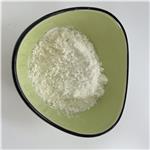
US $10.00-7.00/KG2025-04-21
- CAS:
- 85-42-7
- Min. Order:
- 1KG
- Purity:
- 99%
- Supply Ability:
- 10 mt

US $0.00/Kg/Drum2025-04-21
- CAS:
- 85-42-7
- Min. Order:
- 1KG
- Purity:
- 99%
- Supply Ability:
- 1000mt
